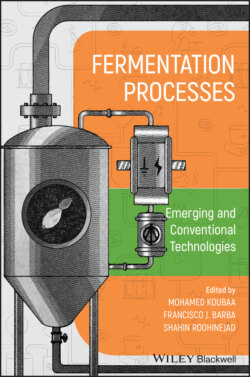Читать книгу Fermentation Processes: Emerging and Conventional Technologies - Группа авторов - Страница 10
1.1.1 Production of Microbial Biomass
ОглавлениеCommercial production of microbial biomass can be divided into two major processes: the production of viable microorganisms used primarily for fermentative applications (Vitorino and Bessa 2017) and the production of microbial cells, usually dead, that can serve as protein‐rich supplements (Matassa et al. 2016).
In the first case, we can cite several examples: the production of bakery yeasts for the production of bread, the production of yeasts to perform alcoholic fermentation (e.g. beers, wines, spirits, etc.), and the production of lactic acid bacteria for the manufacturing of cheese, yogurt, fermented meats (i.e. sausages), or fermented vegetables (e.g. sauerkraut, marinated pickles, etc.). Some food supplements composed of live lactic acid bacteria, also called probiotics, are produced by fermentation. They can be defined as live microorganisms, and the adequate amounts of them supply a health benefit to the host (Otles and Ozyurt 2019). Their role is to exert a beneficial effect by improving the quality of the intestinal flora. These microorganisms are usually supplied as a lyophilized powder in hermetically sealed sterile bags or containers. Generally, the name of ferments is given to microorganisms that serve to start a fermentation process (Koutinas 2017). Some microbial strains such as the bacterium Bacillus thuringiensis, whose spores produce a very effective toxin against pest larvae (biological insecticide), are also grown.
In the second case, it is a question of producing microbial biomass to exploit the nutritional potential of the proteins that it produces (Matassa et al. 2016). This biomass is incorporated into prepared foods to increase their protein content without significant fat intake, which improves their nutritional quality. The yeast Candida utilis is mostly used as a dietary supplement because of its exceptionally high protein content (50–55% of dry weight). This yeast can be used as a valuable raw material to produce various preparations enriched with valuable bioelements (e.g. selenium, magnesium, etc.). The use of such preparations in the human diet provides an interesting alternative to classical, pharmacological supplementation and prevents deficits of important elements, while their addition to feedstock significantly improves the results of animal production (Kieliszek et al. 2017).
